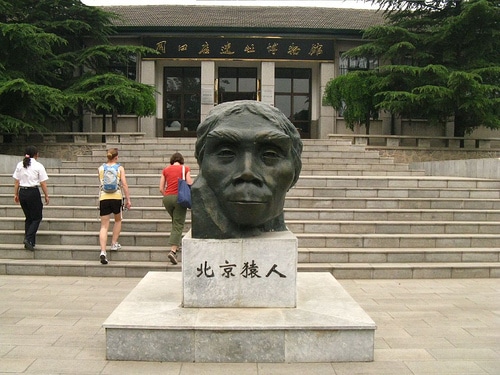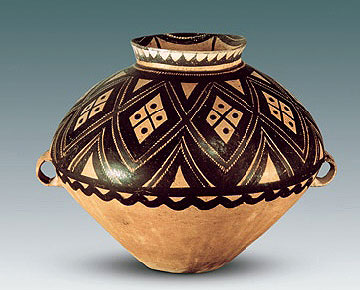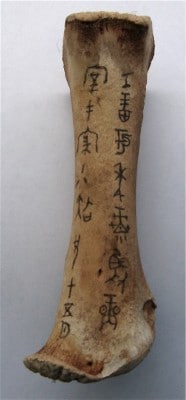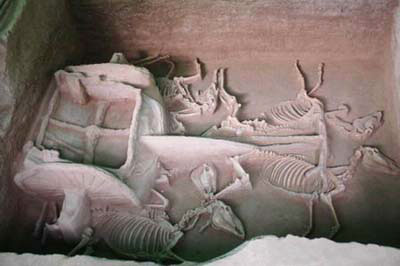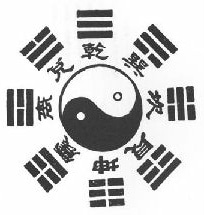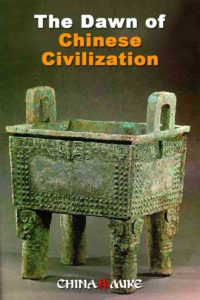The origins of China – or any civilization for that matter – reveal a lot about where it is today. In this article I’ll be discussing China’s Pre-History to 771BC.
Let’s begin this timeline of Chinese history at, well…the beginning. In a small district southwest of the Chinese capital of Beijing, archaeologist discovered one of the first specimen of homo erectus (and subsequently lost it).
China’s Pre-History to 2100 BC
Circa 500,000 BC: In 1918, Swedish paleontologist J.G. Anderson discovers a group of fossils near Beijing (known collectively as Peking Man). Though not a direct ancestor of the Chinese, skulls indicate a brain about two-thirds of modern man. Evidence indicated that Homo eretus could make fire and used primitive stone tools.
Sadly, the original Peking Man skull was lost during World War II while being transported. Despite repeated efforts to find them, the bones’ whereabouts still remain a mystery.
Circa 60,000 BC: Homo sapiens arrive on the scene.
Circa 30,000 BC: Homo sapiens are the last humanoid species left on the planet (in your face Neanderthals!).
Circa 8000-2000 BC : Rise of settlements based on agricultural economy emerged in eastern coastal regions and along rich river deltas of the Yellow River and Yangzi River. These early civilizations relied mostly on hunting, fishing, and gathering.
Cultures later started cultivation of millet and rice, as well as domesticating pigs, water buffalos, and dogs. Remarkably elaborate pottery and jade artifacts dates back to this period, notably from the cultures of the Yangshao (5000-3000BC) and Longshan (3000-2000BC). (see example to the right)
Circa 2700 BC: First evidence of use of tea and the silkworm to make fabrics.
China’s Early “Dynasties”
It’s during this period of time that China starts to see the beginning of a distinctive culture with the three earliest states: The XIA, SHANG, and ZHOU dynasties.
These early “dynasties” weren’t truly unified states, but were instead more of a decentralized, loose alliance of smaller powers.
Let’s take a look at each of these “dynasties” individually for a moment.
The Xia Dynasty [ c. 2100-1600 BC ]
China’s Xia Dynasty was believed to be a small nation made up of a league of tribes. This semi-mythical “first” dynasty of China existed just before written language was developed.
What little is known about the Xia came from unearthed artifacts and fragments of written records during the next dynasty.
One key development of the Xia Dynasty: The first evidence of Chinese metalwork (bronze).
The Shang Dynasty [ c. 1600 – 1050 BC ]
Because so little evidence exists for the Xia Dynasty, the Shang Dynasty is widely considered China’s first dynasty. Experts have debated whether the Shang were real or mythical…until the early 1900’s, when about 20,000 pieces of Oracle Bones (inscriptions on bones and turtle shells) were found in the fields of Henan province.
Before these oracle bones were recognized for what they were, locals thought they were dragon bones and were grinding them up as medicine to cure malaria.
The Shang lived in large complex societies ruled by kings who were considered intermediaries between the living and dead. They were buried in imposing subterranean tombs (near Anyang and Zhengzhou in modern-day Henan province).
Hundreds (possibly slaves) were killed or committed suicide and buried to accompany their king in the afterlife.
The Shang Dynasty is credited for a number of accomplishments including:
- Written Chinese: About 4,000 characters were inscribed on Oracle Bones.
- First Chinese calendar: An astronomical-based system with a 60-day cycle.
- Use of compressed earth for buildings and defensive walls: The city walls around their capital of Zhengzhou enclosed an area of three square kilometers.
- Sophisticated bronze-making: Mass-produced cast bronze using sophisticated clay-molds (not hammer and anvil) to make tools and weapons, as well as pottery and ritual vessels.
The Zhou Dynasty [ 1066-771 BC ]
The Shang is overthrown by rival Zhou, who establish their capital at modern day Xi’an.
The ensuing Zhou Dynasty adopt many Shang-era traditions but with incremental improvements. The practice of “consulting the bones” is replaced by a more sophisticated system of divination: the I Ching (the “Book of Changes”), which is still used today.
The Chinese sense of unique identity and cultural superiority grows. For the first time, China becomes known as Zhong Guo (中国 , meaning “Middle Kingdom”), the same name used by the Chinese today. Outsiders are considered uncivilized “barbarians.”
Replacing the Oracle Bones, during the Zhou Dynasty the people start writing on silk and strips of bamboo.
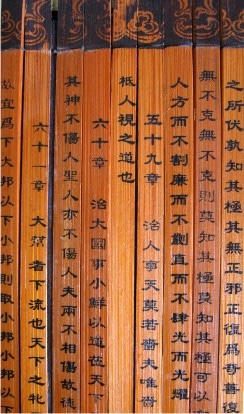
Also notable: rice alcohol is first distilled in China during this time period. (unfortunately the karaoke machine would not be invented until many years later).
Chinese Concept: “Mandate of Heaven”
A vital Chinese concept is born during this period in China’s history: the idea of the “Mandate of Heaven”. This is the idea in which Heaven gives wise rulers a mandate to rule….and takes it away from evil and corrupt ones.
The emperor becomes known as the “Son of Heaven.” This idea will heavily influence Chinese history well into the 1900’s. The mandate was used throughout Chinese history to legitimize ruling dynasties, as well as to question government in times of confusion.

